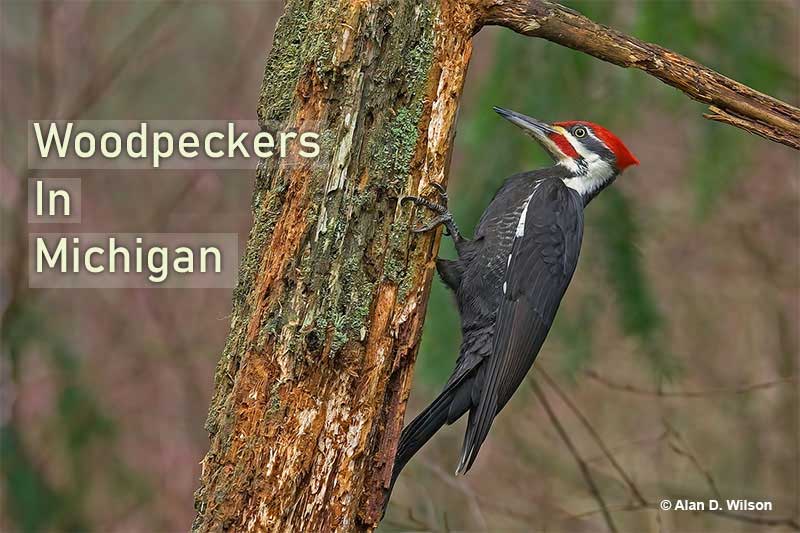
Michigan is a great place to see woodpeckers! These fun and beautiful birds frequent woodland habitats throughout the state. Several species also visit backyard feeders!
In Michigan, there are eight common woodpecker species to spot. How many woodpeckers in Michigan have you seen? Could you identify all of them?
Most Common Woodpeckers in Michigan
Making use of eBird data, we made a list of the eight most common woodpeckers in Michigan.
To help identify these fun little birds and learn where to see them, we also included information about their behavior and key field marks.
Downy Woodpecker

Scientific name: Dryobates pubescens
Length: 6.75 inches
Wingspan: 12 inches
Downy Woodpeckers are small, cute woodpeckers with black and white plumage. They have bold, black and white markings on their heads, black and white wings, and white underparts.
They also have a white back, black rump, and black and white tail. This woodpecker is slightly bigger than a sparrow, and has white, tufted feathers above its short beak.
Males and females can be told apart by a small red patch on the back of their heads – females do not have the patch.
In Michigan, this small woodpecker is common in all sorts of wooded habitats. They like to use their small beaks to peck into twigs and often forage with flocks of chickadees and other birds.
This beautiful little woodpecker is also a regular visitor to backyards and can live in urban areas with lots of trees. They also come to bird feeders, especially ones that offer suet and small nuts.
Key identifications:
- Downy Woodpeckers are smaller than all other woodpeckers in North America. They are nearly as small as a House Sparrow.
- This species has a short and stubby beak (for a woodpecker).
- Downy Woodpeckers have small dark markings on their white outer tail feathers.
Red-bellied Woodpecker
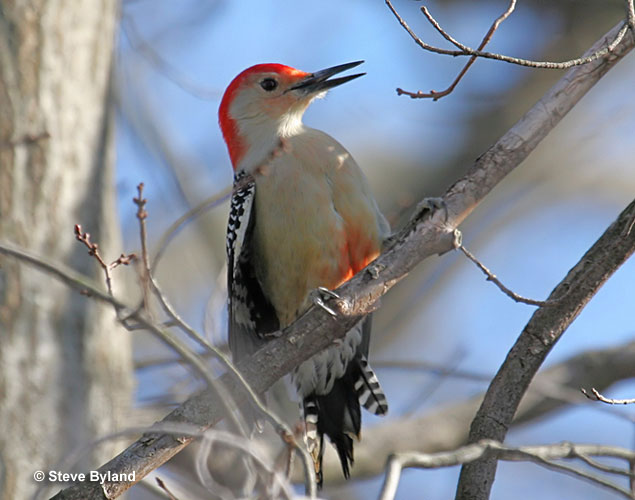
Scientific name: Melanerpes carolinus
Length: 9.25 inches
Wingspan: 16 inches
Red-bellied Woodpeckers are bold birds with backs with zebra-like barring. Despite their name, it’s really hard to see the red on this bird’s underparts! Although they do have a bit of red or reddish-orange, it’s hidden on the lower part of their belly.
Male Red-bellied Woodpeckers have bright red on their crown and nape. Females only have red on their nape and young birds only show a bit of orange on the back of their head.
Red-bellied Woodpeckers are common in Michigan and stay here year-round. They can be seen around all kinds of woodlands. As long as big trees are present, they can even live in urban areas, and often come to feeders.
Key identifications:
- In most of their range, Red-bellied Woodpeckers are the only woodpecker species that has zebra-like, black and white barring on their back and wings.
- Red-bellied Woodpeckers have a pale face and red on their nape.
- This species has plain buff-gray underparts.
Northern Flicker
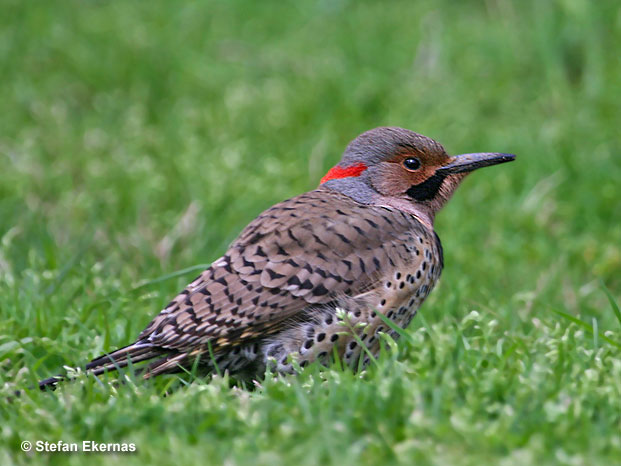
Scientific name: Colaptes auratus
Length: 12.5 inches
Wingspan: 20 inches
Northern Flickers are big, unique, gray and tan woodpeckers with bold white rumps. They have buff underparts with black spotting and a bold black patch on their chest, and fine black barring on their back and wings.
Northern Flickers have some variety in their plumage; the woodpeckers in Michigan have a small red spot on their nape and a black mustache mark (males). They also have bright yellow underwings. They are also known as Yellow-shafted Flickers.
Western birds have grayer heads, and males have a red mustache. They also have reddish on their underwings, which gives them the name Red-shafted Flickers.
Northern Flickers live in Michigan year-round, but their numbers increase once spring arrives.
Key identifications:
- In most of their range, Northern Flickers are the only woodpecker with gray and brown plumage.
- This species has a gray crown and fine black barring on its tan-colored back.
- Northern Flickers also have a black chest patch and black spotting on their underparts.
Hairy Woodpecker
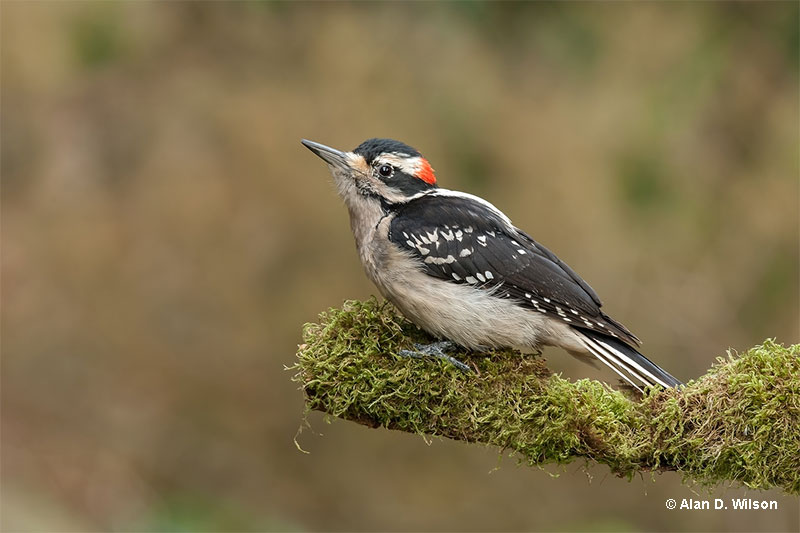
Scientific name: Dryobates villosus
Length: 9.25 inches
Wingspan: 15 inches
Hairy Woodpeckers are medium-sized, black and white woodpeckers with a fairly long and sharp beak. They have a bold black and white pattern on their head, white back, black rump, and black and white wings.
Hairy Woodpeckers also have white underparts and a pale front. Males have a small red patch on the back of their head, females lack this patch, and juveniles have a red patch on top of their head.
If that description sounds like a Downy Woodpecker, it’s true, these two species look almost exactly the same! However, in addition to details mentioned below, they also differ in another main way.
While Downy Woodpeckers like second growth and plants with thin stems, Hairy Woodpeckers only live in places with big, mature trees. We mostly find these woodpeckers in forest but they can also occur in parks and suburban areas that have lots of big trees.
Hairy Woodpeckers can also visit feeders, especially for suet.
Key identifications:
- Hairy Woodpeckers have noticeably longer beaks than Downy Woodpeckers, and are also larger birds.
- The Hairy Woodpecker has a big white patch on its back.
- This species has plain white underparts and clean white outer tail feathers.
Pileated Woodpecker
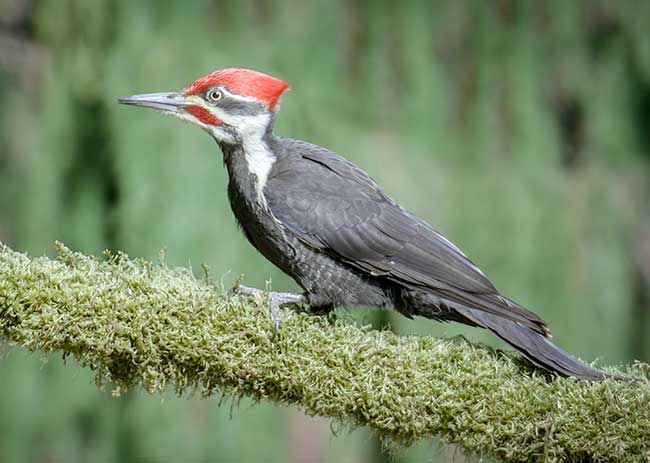
Scientific name: Dryocopus pileatus
Length: 16.5 inches
Wingspan: 29 inches
Pileated Woodpeckers are really big woodpeckers. These unmistakable woodpeckers are mostly black with a thick white line on each side of their neck, and a white throat.
They also have a red crest and a long, grayish beak. Males have a small red mustache, while females have a black line that extends from their beaks to their necks.
Pileated Woodpeckers also have a small white patch on the upper part of each wing. It’s easier to see this mark and the white underwings when the big woodpecker takes flight.
This fantastic woodpecker lives in forests and woodlands with lots of big, mature trees. For that reason, we don’t usually see them in urban areas. However, they can visit feeders at houses next to or within forest!
Key identifications:
- In most places, Pileated Woodpeckers are the only big black and white woodpecker with a red crest.
- This species has a small white patch near the tip of each upperwing. They also have white wing linings.
- Pileated Woodpeckers have a lot of white on their face and a completely black back.
Red-headed Woodpecker

Scientific name: Melanerpes erythrocephalus
Length: 9.25 inches
Wingspan: 17 inches
Red-headed Woodpeckers are beautiful, medium-sized woodpeckers with a completely deep red head. Adults of both sexes look alike and have a sharp gray bill, and bright white underparts.
Their upperparts are glossy black with a snow-white rump, and big white patches on their wings. Juvenile Red-headed Woodpeckers have a similar plumage pattern but have a gray-brown head, and some dark markings on their wings and underparts.
This striking bird prefers semi-open habitats with mature oaks, snags, and other big trees. We see them on golf courses, at the edges of rivers and other wetlands, and other places with similar-looking habitat.
In some places, this beautiful bird also occurs in urban areas, especially in the southeastern USA. They can be spotted in Michigan, but their populations are not too big.
Red-headed Woodpeckers like to peck into trees like other woodpeckers but they also catch insects in flight. With that in mind, we often see them sallying into the air from tall snags next to open areas.
Key identifications:
- Red-headed Woodpeckers are the only woodpecker species in eastern North America with an entirely red head.
- This species has a unique wing pattern with big white patches on the base of each wing.
- The Red-headed Woodpecker has a black tail and an extensive white rump.
Yellow-bellied Sapsucker
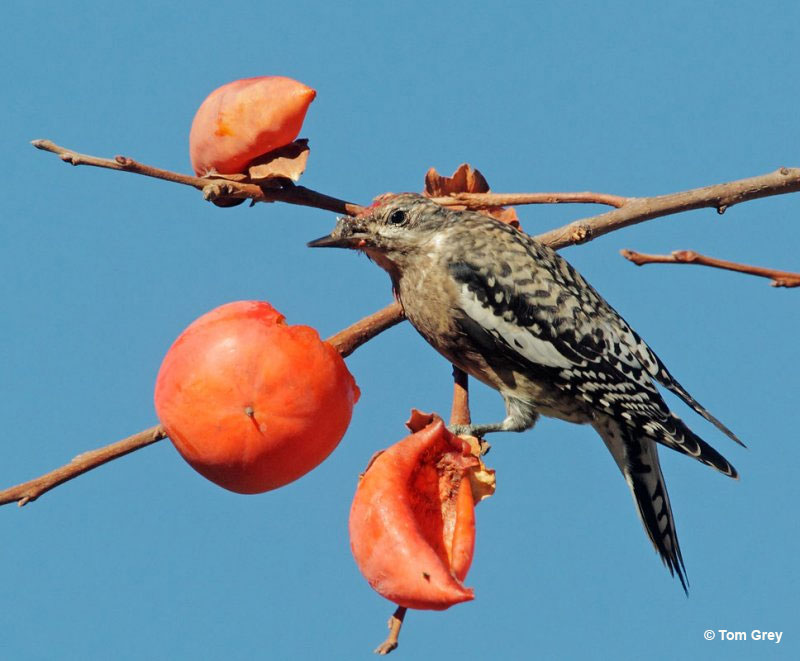
Scientific name: Sphyrapicus varius
Length: 8.5 inches
Wingspan: 16 inches
Yellow-bellied Sapsuckers are pretty, medium-sized woodpeckers with white shoulders. They have a black and white face, black chest, and uneven black and white barring on their backs.
This woodpecker species has pale yellow on its underparts, small black markings on its sides, and a red patch on its head.
Males also have a red throat bordered with black while females have a white throat. Juvenile Yellow-bellied Sapsuckers look like adults but are more dingy gray-brown, and lack red on their heads.
This migratory species likes to peck rows of small holes in deciduous trees. It drinks the sap that comes out as well as insects attracted to the sap.
Yellow-bellied Sapsuckers come to Michigan for breeding season, but some birds stay for the winter, too! They are known to spend the winter in parks and a variety of woodland habitats.
On their breeding grounds, it is easy to identify their distinctive tapping that starts with a few fast taps and then slows down.
Key identifications:
- Yellow-bellied Sapsuckers are the only woodpeckers in most of their range with white shoulders.
- This species has a black chest and uneven barring on its sides.
- The Yellow-bellied Sapsucker has lots of uneven, mottled black and white barring on its back.
Black-backed Woodpecker
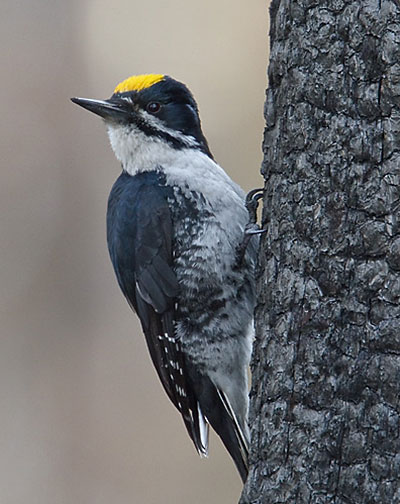
Male. Photograph © Glenn Bartley
Scientific name: Picoides arcticus
Length: 9.1 inches
Wingspan: 16 inches
Black-backed Woodpeckers are medium-sized woodpeckers with jet black upperparts and a broad white stripe on the lower side of their face.
Like most woodpecker species, they have a long, sharp beak, and longish wings. Black-backed Woodpeckers also have pale underparts with uneven dark barring on their flanks.
Both sexes look similar except that male Black-backed Woodpeckers have a bright yellow patch on the top of their head.
These woodpeckers are true birds of cold, evergreen forests. They frequent boreal forests in Alaska, Canada, and some parts of the USA, and also occur in montane forests in parts of the western USA. Interestingly, some Black-backed Woodpeckers seem to favor Michigan.
Key identifications:
- In much of their range, Black-backed Woodpeckers are the only woodpecker species with a completely black back.
- This species can also be recognized by the broad white stripe on the lower side of its face.
- The Black-backed Woodpecker has uneven dark barring on its flanks.
Woodpeckers in Michigan – Frequently Asked Questions
Are woodpeckers common in Michigan?
Yes, woodpeckers are common in Michigan. Eight of the eleven woodpecker species that have been found in the state are common birds.
What is the largest woodpecker in Michigan?
The largest woodpecker in Michigan is the Pileated Woodpecker. This big bird is 16.5 inches long; nearly as big as a crow!
What is a small black and white woodpecker in Michigan?
A small black and white woodpecker in Michigan is the Downy Woodpecker. Only a little bit larger than a sparrow, this small woodpecker is a common sight in backyards, parks, and many other places in Michigan.
Do woodpeckers stay in Michigan all winter?
Yes, most woodpeckers stay in Michigan all winter. The one exception is the Yellow-bellied Sapsucker. This species migrates to the southeastern USA and south all the way to Central America.
Read next: Birds of Michigan | Hawks | Owls | Ducks | Hummingbirds

